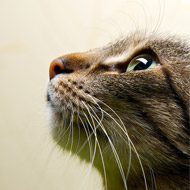
Study reveals recognition of cause and effect
Researchers at Kyoto University in Japan have published a study in ‘Animal Cognition’, outlining how domestic cats deploy a basic understanding of physics and cause and effect.
Combining these principles with their keen sense of hearing, the study begins to explain how they can predict the possible whereabouts of their prey.
The experiment followed on from previous studies by the team that established cats use hearing to predict the presence of invisible objects. The new research involved thirty domestic cats.
The subjects were videotaped during four experimental conditions designed as both congruent and incongruent with the laws of physics.
Using electromagnets, the experimenter was able to control whether a noise was made and whether on turning the container an object dropped out.
The researchers found that the cats were more attentive to the containers that rattled when shaken in anticipation of a falling object.
"Cats use a causal-logical understanding of noise or sounds to predict the appearance of invisible objects," says lead researcher Saho Takagi.
In the experiments that defied the laws of physics, the cats stared longer as if to question the scenario.
Takagi’s interpretation of this response is that cats use sound to predict whether when turned over, an object would fall out, and were puzzled by the inconsistency of the conditions that didn’t comply with causal logic.



 The RCVS has announced a new version of its 1CPD mobile app, with enhanced features for veterinary surgeons and veterinary nurses to record their continuing professional development.
The RCVS has announced a new version of its 1CPD mobile app, with enhanced features for veterinary surgeons and veterinary nurses to record their continuing professional development.